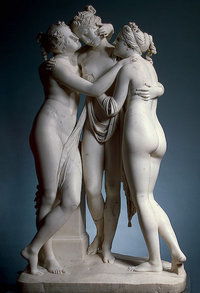|
|
Antonio Canova (November 1, 1757 - October 13, 1822) was an Italian sculptor who became famous for his marble sculptures that delicately rendered nude flesh. The epitome of the neoclassical sculptor, his work marked a return to classical refinement after the theatrical excesses of Baroque art. Canova was born in Possagno in the Province of Treviso where his family had for generations been stone cutters; as a result and he learned to cut marble at a very early age. When only twelve years old he modelled a lion in butter, that was so liked by Signor Falieri that he sent him to be taught by Torretti, the most noted sculptor of the time. He studied ancient art and made many statues of classical subjects, as well as many monuments, busts and statues of living people, among them Napoleon and George Washington. The large fortune which he made was mostly spent in helping the poor, or in assisting other artists, he was made a nobleman and received many honors. Canova died in Venice aged sixty-five and was buried in the town of his birth. His heart was interred in a marble pyramid he designed as a mausoleum for the painter Titian in the church of Santa Maria Gloriosa dei Frari in Venice, now a monument to the sculptor. Among Canova's pupils were the British sculptors Sir Richard Westmacott and John Gibson. Notable works by Canova
) Retrieved from "http://en.wikipedia.org
 |
|
|||||||||||||||||
